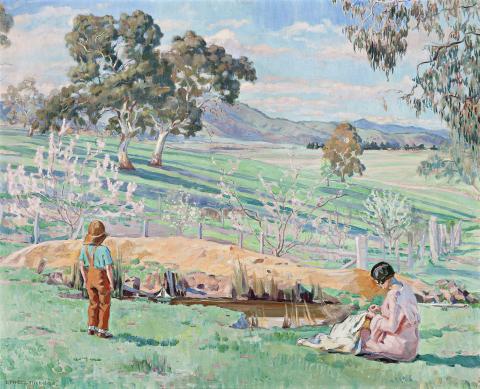SPRING AFTERNOON, KNOCKALONG, 1933
HILDA RIX NICHOLAS
oil on canvas
80.5 x 99.0 cm
signed lower left: E.H. Rix Nicholas
bears inscription on Macquarie Galleries label verso:...34. SPRING AFTERNOON KNOCKALONG / 1933 (MRS. CAVANAGH AND RIX)...
Macquarie Galleries, Sydney (label attached verso)
Dr J. P. Rasmussen OAM, Sydney, acquired from the above in 1978
Hilda Rix Nicholas, 1884 – 1961, Macquarie Galleries, Sydney, 30 August – 18 September 1978, cat. 34 (illus. exhibition catalogue cover)
Paris to Monaro: Pleasures from the studio of Hilda Rix Nicholas, National Portrait Gallery, Canberra, 31 May – 11 August 2013, p. 185 (illus.)
Pigot, J., Hilda Rix Nicholas: Her Life and Art, The Miegunyah Press, Melbourne, 2000, pp. 62, 63, pl. 43 (illus.)
Engledow, S., Paris to Monaro: Pleasures from the studio of Hilda Rix Nicholas, National Portrait Gallery, Canberra, 2013, p. 185 (illus.)
Spring Afternoon, 1933 is a ‘pendant portrait’ to the Shepherd of Knockalong, 1933. These works were painted within days of each other. Young Rix is sporting the same clothing. His shirt and socks have been changed but otherwise he is wearing identical outfits. While the Shepherd of Knockalong has Hilda Rix Nicholas’s son represented on the property, under the watchful care of his father, Spring Afternoon, shows Rix playing with a small model sailing boat on one of the ponds found at Knockalong, under the watchful eye of his Governess, Mrs Cavanagh. She sits nearby, embroidering what appears to be a tablecloth. In this painting, the pastel palette, so often favoured by the artist, has been used to stunning effect. Mrs Cavanagh’s costume, a rather formal dress for station-wear, is a well-cut frock made of a rose-coloured linen that is reflected in the blossoms of the fruit trees that line the pond. These hues resonate in the pastures further in the distance, in the rolling hills that surround them and in the clouds that float across the landscape. The painting is one of domestic tranquillity in the outdoors as Mrs Cavanagh is engaged in the feminine task of needlework and childcare, while Rix occupies himself with keeping an eye on the sailing boat, which idly makes its way over the pond. Neither disturbs the other, there is harmony and peace in this rural Australian landscape in which the fruit trees of the garden, harmonise and co-exist peacefully with the Eucalypts that line the rolling pasture. The foreground of the picture, the enclosure that included the house and the garden, were Hilda’s domain, while the pastures belonged to Edgar. She was boss of one, and he the other.
In an exhibition of her work that was part of a group show at the New South Wales Education Department held in September 1934 she referred to her dual role as mother and artist. The writer of the review noted of the artist ‘Mrs Nicholas said she gave up her chosen work to rear her son, and enjoyed it. But now he is independent of her continued care, she has decided to take up painting once more.’1 Hilda had not expected to be a mother and when at 43 she fell pregnant, she could not contain her delight. She was nevertheless, excited to be able to return to painting. The exhibition included the work of over 120 female artists.
Both pictures are Australian icons that celebrate a way of life that now has faded. They are works that present Hilda Rix Nicholas’s facility for the genre in which she excelled, that of the figure in the landscape. Here she represents the beauty and abundance of life in pastoral Australia that is redolent of the Australia created by the Europeans in the years between the wars and through the talent of a painter who is now recognised as among the nation’s most original and best. When the Sun reviewed her solo exhibition in 1936 the critic noted ‘ We have in our Australian life a great many clever woman painters but this work goes beyond mere cleverness…It’s power is more than feminine though we see in it a womanly love of dress material and flowers and the things of the home, of children and animals and the more gracious things of life.’2
1. ‘Big Display by Women Artists of Australia’, Australian Women’s Weekly, 21 July 1934, p. 21
2. ‘Fine Exhibition by Woman Painter: Mrs Rix Nicholas’, The Sun, 16 June 1936, quoted in Pigot, J., Hilda Rix Nicholas, Her Life and Art, Miegunyah Press, Melbourne, 2000, p. 64
JEANETTE HOORN
Author of Hilda Rix Nicholas and Elsie Rix's Moroccan Idyll: Art and Orientalism, Miegunyah Press, 2012
